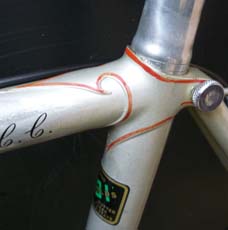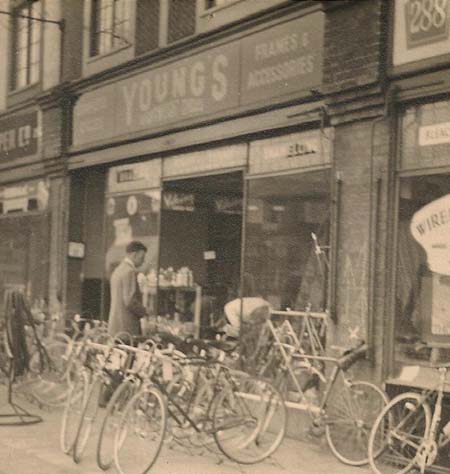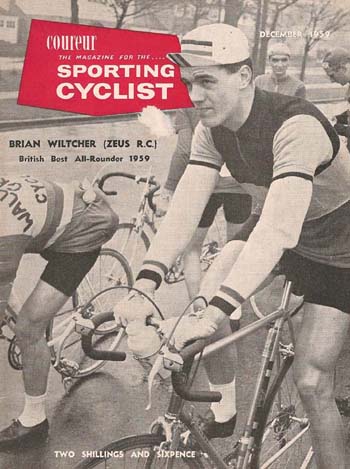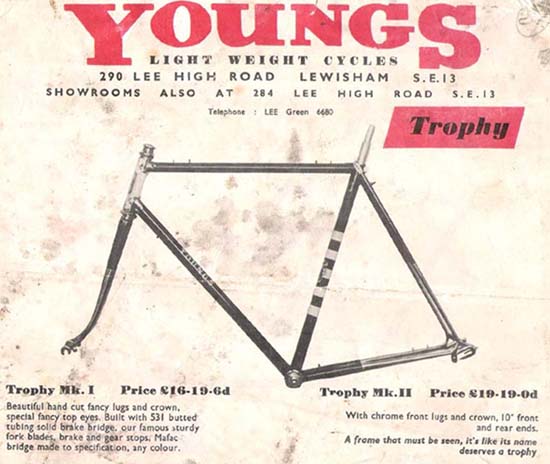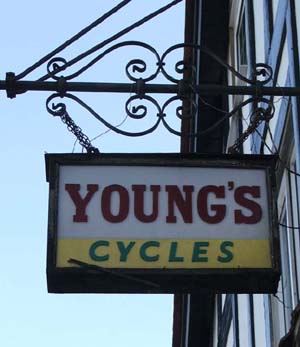Young's Cycles
Posted: Thursday 11th June 2020
E H ‘Ernie’ Young opened his first shop in the spring of 1946 when he was only 16 years of age ‘with the aid of two tenners loaned by his dad’.
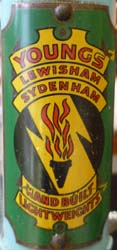
He bought an existing bike shop at 248a Lee High Road, Lewisham near the corner of Lochaber Road, a short distance away from what was to become their principal premises for many years at 290 Lee High Road.
The first address may have been the South London shop of GA Cycles, an important pre war bicycle maker, but was always advertised as 268a Lee High Road a little further along the road.
This first shop was in fact part of a larger one divided in two and it was very narrow and cramped (see photo below) and only just possible to display a cycle long ways in the shop window.
It made a move along the road to larger premises inevitable when the business became more successful. This enterprise was advertised in ‘Cycling’ for three weeks from 26th August 1946 in which Ernie offered re-enamelling, wheel building and all repairs with an accompanying slogan ‘service to a cyclist from a cyclist’. The shop was technically in the same road as a branch of Claud Butler but that was in Lewisham town centre some three quarters of a mile away and hardly serious competition at this time. Ernie was shortly to be joined by his elder brother George who had been in the famous No.1 Commando fighting the Japanese in Burma and recently de-mobbed. George was to go on to become a highly talented and sought after wheel builder.
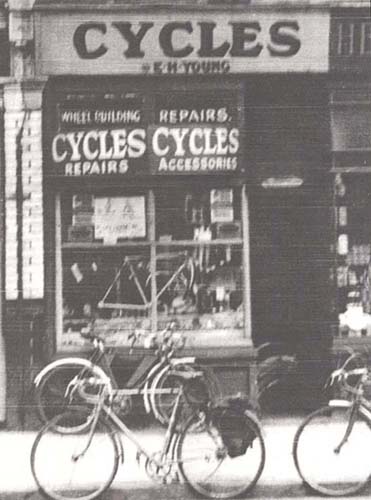
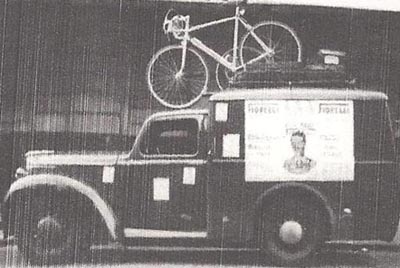
But it was not long before Ernie himself was eligible for National Service. However, this did not stop his cycling activities. Having left the Bellingham Wheelers he joined the league club Polehill RC and was able to act as their mechanic in the first amateur Brighton to Glasgow race in 1952 alongside the notorious Johnny Bowles and driving a 10 HP Commer van that could carry five bikes and riders as well as himself as driver. His team distinguished themselves with a second and seventh place overall. Dave Creasy remembers him driving back from Glasgow then on to the West Country where he was billeted.
Around this time Ernie was able to build his first custom-made bicycle at a cost of £21 19s 6d and began selling lightweight frames under their own name that were built by ex Gillott frame builder, Jim Collier. Unusually, frame numbers started with 116.
This had been the demob number given to Ernie from his time in National Service and was clearly fresh in his mind when he made the decision. It is thought that the frame number sequence reached 1000 in 1958 by racing cyclist Dave Burwood who still remembered this fact after getting his first racing bike from Youngs at the age of 13. That year Ray, Ernie’s youngest brother was given the task of managing a new branch of the business that they opened in Southend Lane, Sydenham. He had joined the firm a year earlier when he was 17 after he could not settle as an office worker. The branch lasted about four to five years but he was to go on to run other branches in Greenwich and West Wickham.
Ray was to get his chance to be part of the support staff for the England team in Yugoslavia in 1963 but this gallivanting came to an end when he married a year later. As Youngs gained in reputation other important developments were taking place in South London that were to have a profound effect on their future direction. In 1960 the Grandini frameset built by Bill Philbrook gained a justifiably high reputation and had been principally marketed from the late 1950s through Meridian Cycles of Forest Hill owned by Pete Benedict who according to Barry O’Leary was someone ahead of his time.
His shop at 11 Sunderland Road was adjoined to a genuine Italian style coffee bar that had pictures of cyclists’ Continental heroes plastered on the walls. (Another branch at 15 Trafalgar Road, Greenwich was run by Sam Curtis that accommodated the Metro CRC HQ in the basement). Pete was influenced by Italian frame design and was a regular visitor to the Milan Cycle Shows and well known to major manufacturers such as Emilio Bozzi at Legnano. He wanted to create a British version of the Cinelli, Bianchi and Fiorelli and achieved this principally through the development of the Grandini which had Cinelli style lugs with an extra long arrow head feature and a domed fork crown, fully flush Cinelli style sloping fork crown or barrel type used by Coppi-Fiorelli. (see photos below)
An abiding feature was the introduction of the fast-back stay with allen key fitting which was to become the symbol of the Grandini in all its guises over the ensuing years. Some enthusiasts will point to Bill Hurlow as the inventor of this feature but the Grandini may have stolen his thunder. Not content with this, Pete had manufactured his own version of the Campagnolo Gran Sport dropouts but with a screw adjuster that was purported to be a sliding block. The lugs and dropouts variously described as ‘Super Sport’ or ‘Grandini’ ends, were manufactured locally according to Dave Creasy.
Ray Young remembers some of them having mudguard eyes, some not. Two prototypes of the Grandini were made by Harry Healy who had apparently been a frame builder at Paris but all subsequent ones were built by the legendary Bill Philbrook. These prototypes were taken to Italy and so impressed them that large orders would have followed until it was known that only one man was making them at the back of the shop in South London or at Gillingham in Kent.
Other marques were also created with their own Continental features that were called the Meridian and Metro. These were advertised alongside their French and Italian counterparts during an intensive advertising campaign in the ‘Sporting Cyclist’ between 1960 and 1961
The Olympic seal of approval was given to the Grandini when one was ridden at Rome in 1960 by the Trinidadian rider Clyde Rimple. (see photo below left). Despite these accolades the firm did not last long. At this time Youngs had a similar advertising campaign with the slogan ‘The Largest “Single” Display in London.’ with 100 lightweight cycles in their walk around showroom.
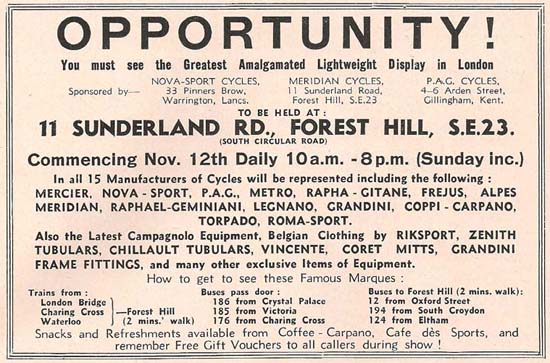
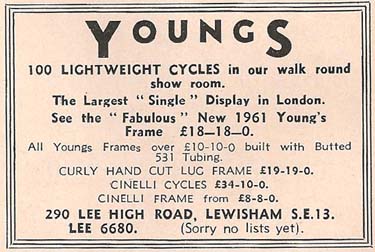
They had marketed their own series of high quality frames built by Wally Green from around 1956/7. Costing from 10 guineas for the ‘Marksman’, made with Nervex Pro lugs through to 18 guineas (£18. 18s .0d) for the ‘Continental’ and ‘Aggressor’ models that had Italian style lugs, there was also a track model, the ‘Piste’. All were built in 531 tubing.
However, their most expensive model that had hand cut curly and fleur de lys lugs, called the ‘Trophy’ cost as much as 19 guineas (£19. 19s 0d) with chrome.(see photo left) A complete bike such as the ten speed Marksman with Campag gears and Mafac brakes could be purchased for as little as £34-10-0d (see image of catalogue below).
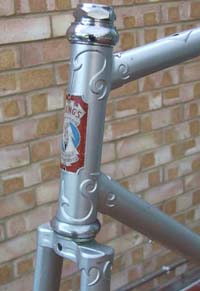
Their team frames at that time were described as having ‘silver and green’ livery. A picture of Bryan Wiltcher astride an Aggressor on the front cover of the December1959 issue of Sporting Cyclist (see image below right) appears to show this as silver with green panels. Although Youngs had their own Italian lugged models and were selling Cinelli cycles in the early 1960s, an opportunity arose to buy the rights to the unique Italian style frames conceived by Pete Benedict, in 1967 at a time when Wally Green’s business was on the wane. From then on the Grandini name was to become synonymous with Youngs whilst Bill Philbrook was retained to make the famous marques for them.
The only stipulation made by Ernie was that they had to be made using Reynolds 531 butted tubing. It is not known what tubing was used for the pre-Youngs examples, possibly Italian or French, but they were considered by Ernie to be on the heavy side. They were featured alongside Youngs own models at the 1967 Lightweight Show held at Earls Court. In an article at the time the Super Sport/Grandini ends were described as ‘flattened on the inside to reduce clearance between the block and the dropout’ and sound reminiscent of ones made by Agrati, although it was possible to order any model with Campag ends if desired.
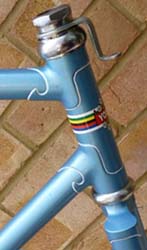
The ‘Meridian’ models originally featured ‘internal crowns’ like the Bianchi and flush sloping fork crowns similar to the Cinelli Super Corsa. Ray described the Metro as having a one-piece head tube lug. This was confirmed when the writer acquired an example of this model (see photo right). It also featured a seat clip and Malaguti rear seat cluster not unlike the pre Coppi – Fiorellis. The ‘Grandini’ was the most expensive model at this time ‘priced at £21 and upwards’, the Meridian starting at 19gns, the Metro £14-10 –0d and Youngs own brand remained at 10gns for the cheapest models.
The late 50s was a period when many bike businesses sponsored their own team of ‘independents’ as well as leading amateurs and Meridian Cycles and Youngs were no exception. Whilst Meridian Cyles were associated with Brian Ward’s Metro CRC team, Youngs supported local boy, ‘British Best All Rounder’ Bryan Wiltcher (Zeus RC) in 1959 and 1960.
He was superseded by a team consisting of Derek Wright, Pat Maskins and John Kilby with Fling drinks as co-sponsors and riding Benelux Super 60 gears. They further supported amateur riders such as Barry O’Leary and George Drewel who belonged to the London Courier CC. In 1968 Youngs also sponsored the full time professional rider Martin Filmer when the racing authorities axed the ‘independent’ category.
After Wally Green’s business went into decline, by the 1970s Youngs turned to Holdsworth (Holdsworthy Co. Ltd) to supply their ‘run of the mill’ frames with the exception of the ‘Grandini’. One supposes that the special lugs and ends had ran out by the mid 1970s and although still a fine frame it lost its uniqueness and began to look like many other frames of the period. The abiding feature being the fastback (or shot-in) stays with allen key binder bolt had by now become ubiquitous. Perhaps less prestigious, the Meridian and Metro marques were phased out.
In later years, the Grandini was built by Chas Roberts after Bill Philbrook became ill and continued into late 1980s as their top model. A certain travel writer by the name of Bettina Selby then living in Blackheath started her career of intrepid peregrinations with a fancy lugged Grandini built up especially by Ernie. The result was her book ‘Riding the Mountains Down’ which is still in print today. Youngs were to build several bikes for her and further books were to follow.
290 Lee High Road continued to be the main address and expanded to include the shop next door (288) (previously a Hairdressers), as well as 284 that was used solely as a showroom. With the Sydenham branch long gone, Ray managed another branch in Trafalgar Road, Greenwich at the corner of Hoskins Street opposite Maze Hill and then moved to 107 and 109 Trafalgar Road a few doors down the road.
By the mid 1980s this branch closed and another premises was purchased at Coney Hall, West Wickham Kent that had previously been the bike shop of Harry Rolands (Harry ‘O’) who was renowned for his wheel building skills. Ray eventually bought the shop outright and continued to run it until he retired in 2004. George had left the business in the 1980s to run a garden centre in Cornwall. The Lee High Road address had been passed to Ernie’s son Stephen then sold off in the 1990s. It is now owned by the Stephens family and ex Holdsworth manager, Bob Donnington can often be seen behind the counter. Ray’s departure marked the end of an era for this great South London marque after a run of almost 60 years but the shop still trades as Youngs Bikes under the management of Martyn Green who specialises in of all things, the Raleigh Chopper, surely an incongruity for the lightweight fan.
Ernie very kindly gave me the few photos he had of the shops in their heyday. He also sent me a copy of a late 1960s catalogue taken from an original in poor condition. Unfortunately the frame books were mislaid during a move. More recently Peter Paine has provided me with a brochure of their models, which is probably from the early 1960s but does not show the Sydenham address. I would like to acknowledge the help given to me by Ernie Young, Ray Young, Dave Creasy, Brian Redfern, Graham Brice, Griff King Spooner, Dave Burwood, Barry O’Leary, Bob Drake and all those who took the trouble to send me photos of their bikes. Sadly, George Young passed away in February 2010 aged 86 .
It is with regret we learned that Ernie passed away in February of 2015. The end of an era.
Posted: Thursday 11th June 2020
This article appears in the following categories.
Upcoming Events
Whether you are looking for a gentle social meet up, or a 100-mile ride browse the community’s upcoming events and plan your next weekend outing.

